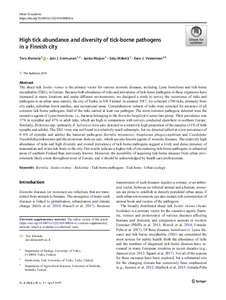High tick abundance and diversity of tick-borne pathogens in a Finnish city
Tero Klemola; Jani J. Sormunen; Janka Mojzer; Satu Mäkelä; Eero J. Vesterinen
https://urn.fi/URN:NBN:fi-fe2021042823373
Tiivistelmä
The sheep tick Ixodes ricinus is
the primary vector for various zoonotic diseases, including Lyme
borreliosis and tick-borne encephalitis (TBE), in Europe. Because both
abundance of ticks and prevalence of tick-borne pathogens in these
organisms have increased in many locations and under different
environments, we designed a study to survey the occurrence of ticks and
pathogens in an urban area, namely, the city of Turku, in SW Finland. In
summer 2017, we collected >700 ticks, primarily from city parks,
suburban forest patches, and recreational areas. Comprehensive subsets
of ticks were screened for presence of all common tick-borne pathogens.
Half of the ticks carried at least one pathogen. The most common
pathogens detected were the causative agents of Lyme borreliosis, i.e.,
bacteria belonging to the Borrelia burgdorferi
sensu lato group. Their prevalence was 37% in nymphal and 47% in adult
ticks, which are high in comparison with surveys conducted elsewhere in
northern Europe. Similarly, Rickettsia spp. (primarily R. helvetica)
were also detected in a relatively high proportion of the samples (11%
of both nymphs and adults). The TBE virus was not found in a relatively
small subsample, but we detected (albeit at a low prevalence of 0–6% of
nymphs and adults) the bacterial pathogens Borrelia miyamotoi, Anaplasma phagocytophilum and Candidatus Neoehrlichia mikurensis and the protozoan Babesia
spp., which are also known agents of zoonotic diseases. The relatively
high abundance of ticks and high diversity and overall prevalence of
tick-borne pathogens suggest a lively and dense presence of mammalian
and avian tick hosts in the city. Our results indicate a higher risk of
encountering tick-borne pathogens in urbanized areas of southern Finland
than previously known. Moreover, the possibility of acquiring
tick-borne diseases from urban environments likely exists throughout
most of Europe, and it should be acknowledged by health care
professionals.
Kokoelmat
- Rinnakkaistallenteet [27094]
